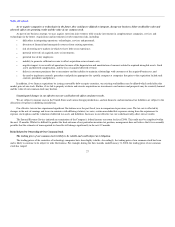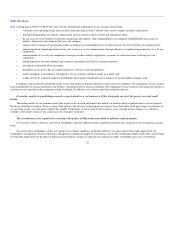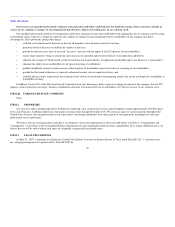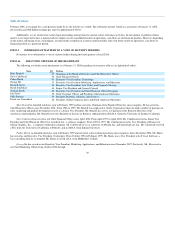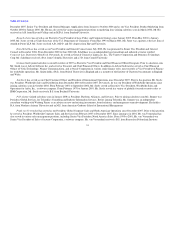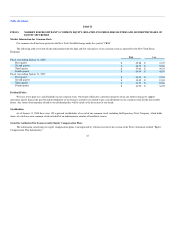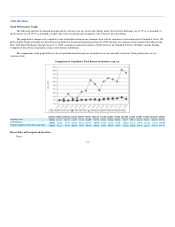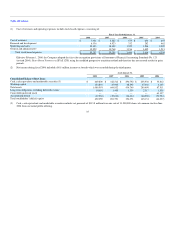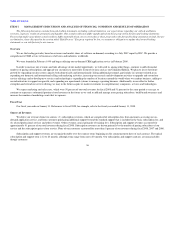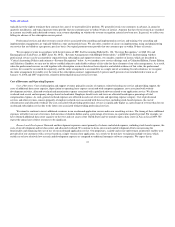Salesforce.com 2007 Annual Report Download - page 40
Download and view the complete annual report
Please find page 40 of the 2007 Salesforce.com annual report below. You can navigate through the pages in the report by either clicking on the pages listed below, or by using the keyword search tool below to find specific information within the annual report.
Table of Contents
typically have the right to terminate their contracts for cause if we materially fail to perform. We generally invoice our customers in advance, in annual or
quarterly installments, and typical payment terms provide that our customers pay us within 30 days of invoice. Amounts that have been invoiced are recorded
in accounts receivable and in deferred revenue, or in revenue depending on whether the revenue recognition criteria have been met. In general, we collect our
billings in advance of the subscription service period.
Professional services and other revenues consist of fees associated with consulting and implementation services and training. Our consulting and
implementation engagements are typically billed on a time and materials basis. We also offer a number of classes on implementing, using and administering
our service that are billed on a per person, per class basis. Our typical payment terms provide that our customers pay us within 30 days of invoice.
We recognize revenue in accordance with the provisions of SEC Staff Accounting Bulletin No. 104, "Revenue Recognition," or SAB 104, and
Emerging Issues Task Force, or EITF, Issue No. 00-21, "Revenue Arrangements with Multiple Deliverables," or EITF 00-21. In determining whether
professional services can be accounted for separately from subscription and support revenues, we consider a number of factors, which are described in
"Critical Accounting Policies and estimates—Revenue Recognition" below. As we introduce new service offerings such as Unlimited Edition, Partner Edition
and Salesforce Sandbox, we may not be able to establish objective and reliable evidence of fair value for these elements of our sales arrangements. As a result,
when the professional services are sold together with subscription services that do not have objective and reliable evidence of fair value, the professional
services fees cannot be accounted for separately, and the entire arrangement is accounted for as a single unit of accounting. In such situations, we recognize
the entire arrangement fee ratably over the term of the subscription contract. Approximately 8 percent and 5 percent of our total deferred revenue as of
January 31, 2008 and 2007 respectively, related to deferred professional services revenue.
Cost of Revenues and Operating Expenses
Cost of Revenues. Cost of subscription and support revenues primarily consists of expenses related to hosting our service and providing support, the
costs of additional data center capacity, depreciation or operating lease expense associated with computer equipment, costs associated with website
development activities, allocated overhead and amortization expense associated with capitalized software related to our application service. We allocate
overhead such as rent and occupancy charges based on headcount. Employee benefit costs and taxes are allocated based upon a percentage of total
compensation expense. As such, general overhead expenses are reflected in each cost of revenue and operating expense category. Cost of professional
services and other revenues consists primarily of employee-related costs associated with these services, including stock-based expenses, the cost of
subcontractors and allocated overhead. The cost associated with providing professional services is significantly higher as a percentage of revenue than for our
on-demand subscription service due to the labor costs associated with providing professional services.
We intend to continue to invest additional resources in our on-demand application service and in our consulting services. The timing of these additional
expenses will affect our cost of revenues, both in terms of absolute dollars and as a percentage of revenues, in a particular quarterly period. For example, we
have obtained additional data center capacity on the west and east coasts of the United States and we intend to open a data center in Asia in fiscal 2009. We
expect the annual cost of these resources to be significant.
Research and Development. Research and development expenses consist primarily of salaries and related expenses, including stock-based expenses, the
costs of our development and test data center and allocated overhead. We continue to focus our research and development efforts on increasing the
functionality and enhancing the ease of use of our on-demand application service. Our proprietary, scalable and secure multi-tenant architecture enables us to
provide all of our customers with a service based on a single version of our application. As a result, we do not have to maintain multiple versions, which
enables us to have relatively low research and development expenses as compared to traditional enterprise software companies. We expect that in
37


